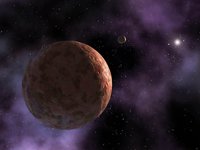A Cosmic Crash

Two small planets hurtle toward each other at 22,000 miles per hour. They're on a collision course. With unimaginable force, they smash into each other in a flash of light, blasting streams of molten rock far out into space.
This cataclysmic scene has happened countless times in countless solar systems. In fact, scientists think that such collisions could have created Earth's moon, tilted Uranus on its side, set Venus spinning backward, and sheared the crust off Mercury.
But witnessing such a short-lived collision while pointing your telescope in just the right direction would be a tremendous stroke of luck. Well, astronomers using NASA's Spitzer space telescope recently got lucky.
“It's unusual to catch such a collision in the act, that's for sure,” said Geoffrey Bryden, A cosmic Crashspitzer_an astronomer specializing in extrasolar planet formation at NASA's Jet Propulsion Laboratory and a member of the science team that made the discovery.
When Bryden and his colleagues pointed Spitzer at a star 100 light-years away called HD 172555, they noticed something strange. Patterns in the spectrum of light coming from nearby the star showed distinctive signs of silicon monoxide gas — huge amounts of it — as well as a kind of volcanic rock called tektite.
It was like discovering the wreckage from a cosmic car crash. The silicon monoxide was produced as the high-speed collision literally vaporized huge volumes of rock, which is made largely of silicon and oxygen. The impact also blasted molten lava far out into space, where it later cooled to form chunks of tektite.
Based on the amount of silicon monoxide and tektites, Bryden's team calculated that the colliding planetary bodies must have had a combined mass more than twice that of Earth's moon. The collision probably happened between 1,000 and 100,000 years ago — a blink of an eye in cosmic terms.
The scientists used the Spitzer space telescope because, unlike normal telescopes, Spitzer detects light at invisible, infrared wavelengths.
“Spitzer wavelengths are the best wavelengths to identify types of rock,” Bryden says. “You can pin down which type of rock, dust, or gas you're looking at.”
Bryden says the discovery provides further evidence that planet-altering collisions are more common in other star systems than people once thought. The “crash-bang” processes at work in our own solar system may indeed be universal. If so, Spitzer has a front row seat on a truly smashing show.
See Spitzer Space Telescope's brand new Web site at http://spitzer.caltech.edu/. Kids can learn about infrared light and see beautiful Spitzer images by playing the new Spitzer Concentration game at http://spaceplace.jpl.nasa.gov/en/kids/spitzer/concentration.
This article was provided by the Jet Propulsion Laboratory, California Institute of Technology, under a contract with the National Aeronautics and Space Administration.





















